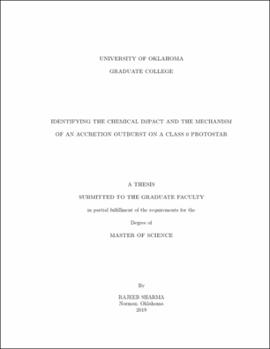| dc.description.abstract | Past and present observations of luminosity bursts in various young protostars provide increasing evidence that episodic accretion is a common phenomenon in protostellar evolution. Studying these outbursting systems can help reveal the dynamics of mass accretion in protostars and constrain the properties and nature of protostellar disks. I present a study of the youngest known outbursting protostar, HOPS 383, a Class 0 protostar in the Orion molecular cloud using observations from the Submillimeter Array (SMA), the Atacama Large Millimeter/submillimeter Array (ALMA), and the Very Large Array (VLA). First, I use the SMA to study the effect of the outburst on the chemistry of the disk and the envelope around HOPS 383. The SMA observations show peaked HCO+ and H13CO+ and reduced N2H+ at the protostar position, consistent with chemical models of outbursting YSOs where the evaporating CO increases HCO+ and decreases N2H+. Second, I present dust continuum observed with the ALMA at 0.87 mm and the VLA at 9 mm to constrain the disk properties and understand its role in protostellar evolution. Both the continuum show a well-resolved disk orthogonal to the outflow. The outflow is traced by 12CO, evident both in the SMA and the ALMA data, suggesting that HOPS 383 is quite young. Assuming isothermal and optically thin dust emission, I estimate the current disk mass between 0.043 Msun and 0.15 Msun. To assess of gravitational instability (GI) as the cause of the outburst, I calculate Toomre's Q ~1.14 and ~0.87 pre-outburst, using the ALMA and the VLA derived disk masses, respectively. Finally, modeling the resolved continuum from the ALMA and the VLA using 3D radiative transfer code gives disk masses of 0.1 Msun and 0.065 Msun for the ALMA only models and disk masses of 0.25 Msun and 0.21 Msun for the ALMA+VLA models. The disk temperature and surface density profiles from the modeling suggest that Toomre's Q < 1 for most cases before the outburst, suggesting that GI possibly drove the outburst in HOPS 383 and is a viable mechanism to explain outbursts at an early age if the disk is sufficiently massive. | en_US |
